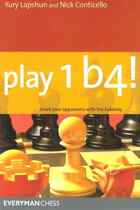Play 1.b4!
Nick Conitcello, Yury Lapshun

The Sokolsky Opening, also known as the Orangutan, creates an odd impression. In fact, most players have trouble taking things seriously when 1.b4 is trotted out. Though Ive never played 1.b4, I did go through a period where 1.Nf3 Nf6 2.c4 g6 3.b4 was a major (and successful) part of my repertoire! Strange how I cringe when seeing 1.b4, but glow with admiration when 1.Nf3 Nf6 2.c4 g6 3.b4 appears (Clearly, the human mind often makes no sense at all!). I adopted it because Reti used this move order to wipe the floor with Capablanca in a famous game at NY 1924 this whole game is given in Play 1.b4!
Over the course of my chess career I have seen several rather strong players (Class A to low Master) who specialized in this advance of the b-pawn. From watching their games (and sometimes having to play against 1.b4), I had the impression that this move usually leads to closed, ponderous positional struggles where the stronger player, or the player most familiar with these kinds of positions, usually prevailed. Yes, Ive long been aware of 1.b4 e5 2.Bb2 Bxb4 3.Bxe5 Nf6, which leads to an open, sometimes extremely sharp, game (and this eventually became my choice as Black vs. 1.b4). But other than that, 1.b4 had to be a grueling slog, didnt it? Well, apparently not! After getting Play 1.b4! in the mail and looking it over for a couple days, I realized that there were several things I wasnt aware of:
1) There are actually effective gambit lines here! For example, 1.b4 e5 2.Bb2 f6 3.e4 Bxb4 4.Bc4! Ne7 5.f4 with sharp play.
2) Fischer played the Sokolsky in simultaneous exhibitions! For example, Fischer-Gloger, Cleveland 1964 saw the previously mentioned gambit line: 1.b4 e5 2.Bb2 f6 3.e4 Bxb4 4.Bc4! Ne7 but now, instead of 5.f4, he gave the more common 5.Qh5+ a try and got a winning position after 5… Ng6 6.f4 exf4 7.Nf3 Nc6 8.Nc3 Bxc3 9.Bxc3 d6 10.Nh4 Nce7 11.Nf5 Kf8 12.Bxf6! Black lasted until move 17 before resigning.
3) The Kings Gambit f2-f4 appears surprisingly often: 1.b4 e5 2.Bb2 f6 3.e4 c6 (refusing to take the bait on b4) 4.f4 exf4 5.Bc4 Qe7 6.Qe2. Clearly not the boring positional garbage that I had envisioned!
4) Yes, closed positions are the rule, but they dont necessarily have to be dull. For example: Sokolsky-Zhukhovitsky, Kiev 1945 went 1.b4 e5 2.Bb2 f6 3.b5 d5 4.e3 Bd6 5.c4 c6 6.Nf3 Ne7 7.d4 e4 8.Nfd2 0-0 9.Nc3 with something akin to a reversed French Defense on steroids has appeared.
5) My favorite line is still alive and kicking, and is clearly one of blacks best choices: 1.b4 e5 2.Bb2 Bxb4 3.Bxe5 Nf6 4.c4 0-0 5.Nf3 Nc6 6.Bb2 Re8 7.e3 d5 8.cxd5 Nxd5 9.Be2. This is Lapshun-Sin, World Open 2003. Here Black went berserk with 9 Rxe3? 10.fxe3 Nxe3. However, it just doesnt work and he went down in a humiliating 18 moves.
6) In this line (after 1.b4 e5 2.Bb2 Bxb4 3.Bxe5 Nf6 4.c4 0-0 5.Nf3 Nc6 6.Bb2 d5 7.cxd5 Nxd5 8.e3) I wasnt aware of an idea played by the 12 year old Senior Master, Ray Robson: 8… Qd6, intending Qg6 hoping to wipe White out on the kingside. Black lost that game (vs. Lapshun), but Robsons plan makes good sense.
7) Some time ago, I had noticed 1.b4 d5 2.Bb2 Qd6 when I took it for granted that 3.b5 Qb4 picked up a pawn. In fact, I started using this in online blitz and victimized many players with this “trap. So imagine my surprise when Lapshun gave 3… Qb4 a question mark with the follow-up 4.Bc3 Qxb5 5.e4 “with the initiative. Well, I dont know about this. A pawn is a pawn, and any graduate from the Larry Evans school of chess would gobble it in ecstasy. But keep in mind that Lapshun is a crazed attacking player and thus would probably be as happy to have the initiative as I would be in having his pawn!
Of course, if youre not inclined to sacrifice pawns with reckless abandon, then 1.b4 d5 2.Bb2 Qd6 3.a3 is the way to go, when 3 …e5 4.Nf3 f6 (Lapshun says this is “essential, but Im not sure that this is really the case.) 5.e3 Be6 6.d4 e4 7.Nfd2 f5 8.c4 c6 9.Nc3 Nf6 leads to the usual high-tension positions (as in Sokolsky-Villard, Kiev 1955) which offer White plenty of chances (in fact, White grabbed the advantage with 10.Qc2! a6 11.Na4 Qd8 12.Nc5 Bc8 13.Rc1 and went on to win a nice game).
As you can see, there is plenty of stuff for both positional and tactical players. The book is often conversational, and Lapshuns love for this system is both obvious and motivational. I feel that 1.b4 is ideal for players who are sick of opening theory and want a line that will confound most opponents, while offering real chances to get positions they both know and, with practice, excel at.
Recommended for players under 2200, or anyone that just wants to get off the beaten path and play some original chess.
